The impact of war on artists can be profound. Terrible sights and awful experiences are transformed into works of art that honour acts of courage and move the soul, or they record immense cruelty in chilling images of man's inhumanity to man. The war artist Jack Shadbolt, who died on 22 November 1998, found both honour and horror in the more prosaic existence of the home front and service behind the lines. His legacy is an important body of work on the war and its impact on the human spirit.
Jack Shadbolt was born in Shoeburyness, England, in 1909. When he was three his family immigrated to Canada, finally settling in Victoria, British Columbia, in 1914. Exposure to the art of Emily Carr and the Group of Seven, combined with a burgeoning interest in outdoor sketching, led to his decision to become an artist. He later studied in New York, London, and Paris, and in 1938 began teaching at the Vancouver School of Art.
He enlisted in the army as a signalman on 28 October 1942. Preferring to paint, he devoted time during training to recording the setting and activities of Little Mountain Camp, B.C. In May 1944 the Canadian War Artists' Committee identified him as one of a number of suitable candidates for commission as an official war artist, but there were no vacancies in the army. Instead, he became a "narrator," with the rank of major, on the staff of the Director of Historical Services, Ottawa, pending a vacancy in the war artist establishment.
Beginning on 23 October 1944, he spent three weeks painting and sketching at the German prisoner of war camp at Petawawa, Ontario. The 32 works on paper he produced there form the main body of his art at the Canadian War Museum. Executed in watercolour and pencil, Shadbolt's subjects include portraits of the Veterans Guard of Canada, the German prisoners, work parties, and several detailed portrayals of the bleak camp itself. In these camp studies, the barbed wire fences, the watchtowers, and the ramshackle wooden huts document with chilling thoroughness one aspect of Canada's war on the home front.
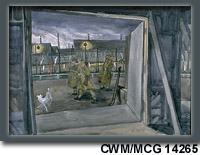
|
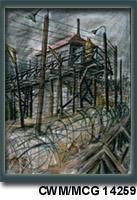
|
| Incoming and Outgoing Guards | A Corner of the Compound |
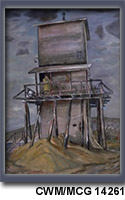
|
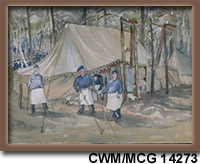
|
| Guards on the Water Tower | A Corner of the Compound |
In February 1945 Shadbolt travelled to London, where he was to assist with administration duties at Canadian Military Headquarters in connection with the war artists' program. While there, he completed several watercolours of the bomb-damaged city, four of which now complete the Shadbolt collection in the Canadian War Museum's holdings.
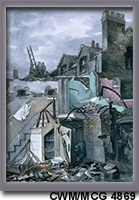
|
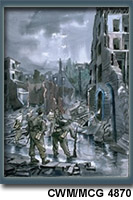
|
| Poking in the Ruins | Troops Advancing in the Rain |
This subject was a continuing inspiration in his subsequent work, not simply as a symbol of the destructiveness of war but, more importantly, because the ruins enabled him to understand the nature of abstraction. In an interview on 26 April 1980 with the art historian and curator Ian Thom, Shadbolt explained:
"I was aware of the nature, it suddenly dawned on me, about this business of abstraction. I always think abstractly but the problem was that it didn't come into the work. And it is this, that when the bomb blows the building apart it abstracts it, the pieces fall back together again and you get a memory image of what was there but vastly altered and psychologically made infinitely more intense than the original thing. So that was a process of abstracting. Well, I started thinking of bomb ruins in terms of 'here was a building and here are the abstract elements of it.' I worked from there."(1)
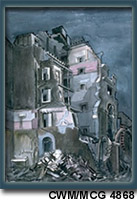
Bombed Naval and Military Hotel, South Kensington
During his London sojourn, Shadbolt was responsible for sorting and cataloguing the photographs taken by the Army Signal Corps at the Nazi concentration camps of Belsen and Buchenwald.
The effect of this horrific exposure emerged in a series of paintings beginning in 1946 after his return to Canada.
For the next 50 years Shadbolt consolidated his position as one of Canada's most innovative and important artists. He was an inspiration and a mentor to many. Although his career as a war artist was brief, with the support of those responsible for the war art programs, he was given opportunities to witness and paint events that were to have an impact on his development as an artist. The art that emerged after his wartime service is a profoundly moving visual inheritance. His achievement is to have seen beyond the immediate theatre and action to the human tragedy that underlies all conflict.
